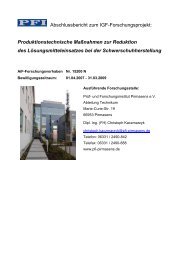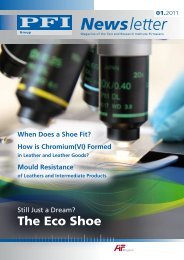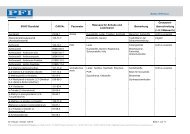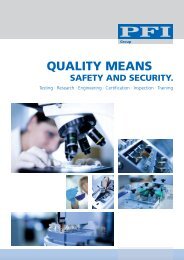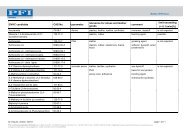newsletter - Point of Shoes kommt gut an
newsletter - Point of Shoes kommt gut an
newsletter - Point of Shoes kommt gut an
Sie wollen auch ein ePaper? Erhöhen Sie die Reichweite Ihrer Titel.
YUMPU macht aus Druck-PDFs automatisch weboptimierte ePaper, die Google liebt.
Research | Forschung<br />
Inline process control should be employed in the following<br />
production steps:<br />
1. Incoming goods inspection:<br />
Mould release agents <strong>an</strong>d other surface contamin<strong>an</strong>ts<br />
should be discovered at this stage. Identification <strong>of</strong> the<br />
materials to be cemented might also be possible.<br />
2. Monitoring <strong>of</strong> surface pre-treatment:<br />
Surface pre-treatment should be monitored <strong>an</strong>d in the<br />
case <strong>of</strong> <strong>an</strong> integrated cle<strong>an</strong>ing step also the removal <strong>of</strong><br />
contamin<strong>an</strong>ts.<br />
3. Monitoring <strong>of</strong> drying:<br />
On completion <strong>of</strong> the drying step the residual moisture <strong>of</strong><br />
the adhesive film should be examined <strong>an</strong>d thus approved<br />
for the next production step. In the case <strong>of</strong> excessive<br />
moisture, it should be possible to automatically adjust the<br />
drying time by altering the belt speed in drying tunnels.<br />
4. Activation <strong>of</strong> adhesive films:<br />
The surface temperature <strong>of</strong> the adhesive films should be<br />
controlled in order to assure optimal bonding <strong>of</strong> the adhesive<br />
films on joining <strong>of</strong> sole <strong>an</strong>d upper.<br />
The pl<strong>an</strong>ned two-year project on development <strong>of</strong> in-line<br />
process control (AiF proposal N04277/09) will probably<br />
start on 01.02.2010 <strong>an</strong>d is funded by the Germ<strong>an</strong> Federal<br />
Ministry <strong>of</strong> Economics <strong>an</strong>d Technology via the Germ<strong>an</strong><br />
Association <strong>of</strong> Industrial<br />
Research Org<strong>an</strong>isations (AiF).<br />
Further information:<br />
Dipl.-Ing. (FH) Christoph Kaczmarzyk,<br />
Tel.: +49 6331 2490 842<br />
E-Mail: christoph.kaczmarzyk@pfi-pirmasens.de<br />
45<br />
2.2009<br />
Beurteilung der erwähnten Einflussfaktoren vorzunehmen<br />
und damit Fehlklebungen mit Dispersionsklebst<strong>of</strong>fen auf<br />
ein Mindestmaß zu reduzieren. Dies würde die Akzept<strong>an</strong>z<br />
dieses Verklebungsverfahrens in der Schuhindustrie deutlich<br />
erhöhen und damit zur Entlastung der Umwelt durch<br />
die Substitution von Lösungsmitteln beitragen.<br />
Die Inline-Prozesskontrolle soll bei folgenden Arbeitsschritten<br />
eingesetzt werden:<br />
1. Materialeing<strong>an</strong>gskontrolle:<br />
An dieser Stelle sollen Trennmittel oder <strong>an</strong>dere Oberflächenverschmutzungen<br />
entdeckt werden. Eventuell ist<br />
auch eine Identifikation des zu verklebenden Materials<br />
möglich.<br />
2. Überwachung der Oberflächenvorbeh<strong>an</strong>dlung<br />
Die Oberflächenvorbeh<strong>an</strong>dlung soll überwacht werden<br />
und bei integriertem Reinigungsschritt auch die Reinigung<br />
von Verschmutzungen.<br />
3. Überwachung der Trocknung:<br />
Am Ende des Trocknungsschritts soll die Restfeuchtigkeit<br />
des Klebst<strong>of</strong>ffilms untersucht werden und somit eine<br />
Freigabe für die nächsten Arbeitsschritte erfolgen. Bei zu<br />
hoher Feuchtigkeit ist eine automatische Anpassung der<br />
Trocknungszeit zur Änderung der B<strong>an</strong>dgeschwindigkeit<br />
bei Trockentunneln denkbar.<br />
4. Aktivierung der Klebst<strong>of</strong>ffilme:<br />
Die Oberflächentemperatur der Klebst<strong>of</strong>ffilme soll kontrolliert<br />
werden, um eine optimale Verbindung der Klebst<strong>of</strong>ffilme<br />
beim Fügen von Sohle und Schaft zu gewährleisten.<br />
Das gepl<strong>an</strong>te zweijährige Projekt zur Entwicklung der<br />
Inline-Prozesskontrolle (AiF-Antrag N04277/09) wird<br />
voraussichtlich am 1. Februar 2010 beginnen und ist über<br />
die Arbeitsgemeinschaft industrieller Forschungsvereinigungen<br />
(AiF) vom Bundesministerium für Wirtschaft und<br />
Technologie gefördert.



